Haaalp,
I've Been Stung
by a "Bee."
Knowledge
is the best protection you can have.
Bees are many times
falsely blamed by people for the actions of yellow jackets, which,
along with fire ants in
the south, are the source of most stings.
The first thing one must do when
encountering any of these feared creatures is to identify them. For
some people, anything
that stings is a "Bee" (and must be destroyed!). Paranoia and ignorance
can
backfire on us in many ways.
There are lots of myths about
"bee stings" even in the medical community. Being told by an
emergency
room doctor that "The next sting could kill you!" is more of a
statement to
"cover his bee-hind" than it is a legitimate warning.
"Bee stings are usually not
by bees at all, but the medical community and the statistics on them do
not distinguish
between stinging insects. Yet the venoms are quite different. Honeybees
sting to protect
their home, and the primary purpose is to cause irritation and pain.
Wasps and hornets
sting to parallize their prey, and their stings contain more powerful
toxins. Fire ants
have yet another venom formula.
Panic can become a
self-fulfilling prophecy; indeed systemic reactions can be caused by
panic. The physical
condition of the "stingee" is quite important. Healthy folks are
extremely
unlikely to have more than discomfort with a sting or two. But people
with high blood
pressure, heart problems, or diabetes can suffer much greater effects.
Identifying
the
"Bee"
See also: What's Buzzin' in My
Garden?
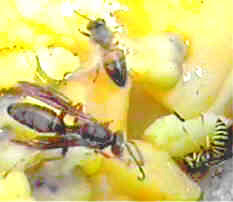 |
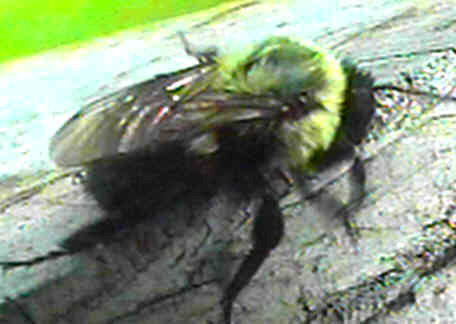
|
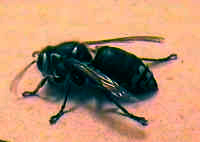
|
|
Honeybee
Polistes
wasp
Yellow Jacket
|
Bumblebee
|
White
Faced Hornet
|
|
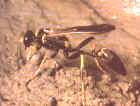
Mud Dauber
(image thanks to Rick Matthews)
|
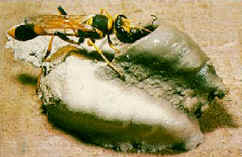
Mud Dauber on Nest
(image thanks to Rick Matthews)
|
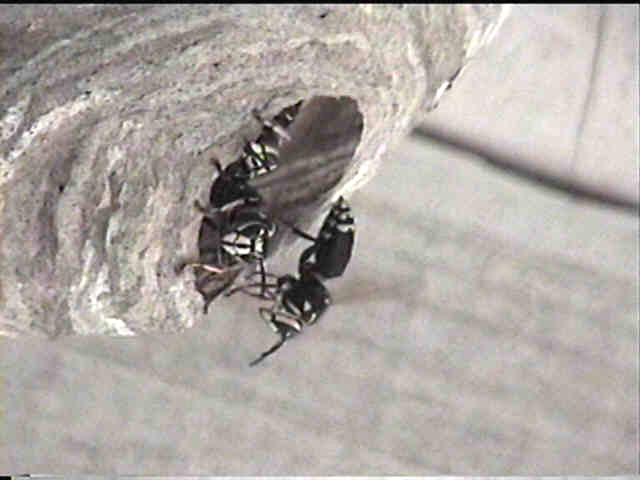
Hornet
Nest Entrance
|
|
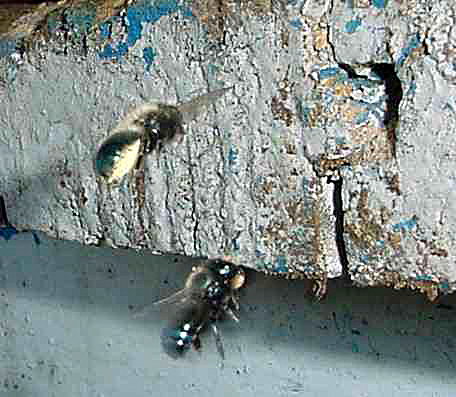
Mason bees in cracks in tongue and groove. Note pollen on abdomen. Must
be grabbed to incur stinging.
|
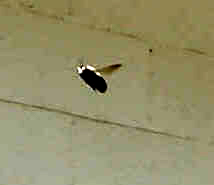
Carpenter Bee Drones will hover around you. They are curious, not
aggressive and cannot sting.
|

Carpenter Bee Female
While capable of stinging, she generally is so busy with the flowers
that she will ignore you
|
The most frequent
cause of stings by honeybees are from going barefoot in the clover.
Honeybees, while
visiting flowers are never aggressive, and will move away when
threatened. But they will
sting (reflexively) if stepped upon. Sometimes gardeners who pick
cucumbers or summer
squash without looking, will incur a sting when they grab a bee. These
crops have bloom
and maturing vegetables at the same time. Otherwise the most
frequent cases of being
stung by honeybees are at the "homes" of the bees, the hives, which
bees will
defend, sometimes vigorously. If you keep bees, you will
get stung; beekeepers
have to accept that, or they will not be beekeepers long.
|
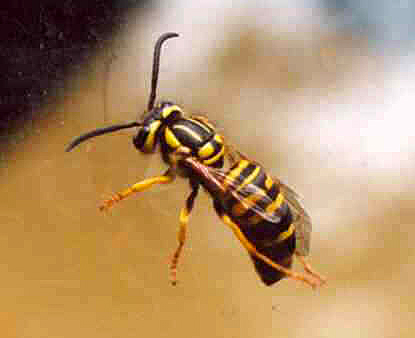
Yellow Jackets
are NOT Bees.
|
Yellow
jackets, particularly the introduced german yellow jacket, which has no
native enemies, will overpopulate and become a pest in late summer and
fall. They are often encountered while mowing lawns, as they frequently
choose to live in an old mouse hole, which they enlarge. Simply running
the mower over them will cause great numbers to fly out, in "attack"
mode. Hornets and paper wasps, build large colonies made from a
paperlike material, and both are extremly territorial, responding to
any perceived threats with great numbers of stings. We create
many of the fall problems with yellow jackets by our own ignorance. |
Some species of bumblebee
can be quite defensive, others are very docile. Bumblebees, because of
their important
role as pollinators, are protected by law in some areas of the world.
Mud daubers, digger bees, cicada
killer wasps, sand wasps, carpenter bees and the semi-social polistes
wasps are capable of
stinging, but rarely do, and should all be protected, because they are
highly beneficial.
A person with the attitude of "all MUST die" is
going to do a lot
of environmental damage. Even those who can sting with vigor
should be protected
whenever we can do so. We have had a nest of hornets by our back door
this past summer.
When we use the door, we pass within about 8 feet of the nest. It is a
large and busy
nest. The only time there has been a problem with them is when we were
loading the car for
a trip, one morning, and we thoughtlessly slammed the door several
times. Then they got
sassy! But we simply left them alone, and they were fine in an hour.
Meanwhile they
have kept our lawn and garden free of many different worms. This is the
first time I ever
raised tomatoes without seeing a single tomato worm. Hornets
are also protected by
law in some places.
(This is an unfinished work,
hastened to publication because this is yellow jacket season (9-10-00)
and so many folks
are asking. More is to be forthcoming as soon as we can get
it together.)
Coming
soon:
-
More
specifics on each type of stinging insect:
-
Deciding
what needs to be controlled and what should be protected:
-
Control
without pesticides:
-
Common
sense on allergies:
-
The
ibuprofen connection:
Alergia
a las picaduras de abejas y avispas (in Spanish)
Home









